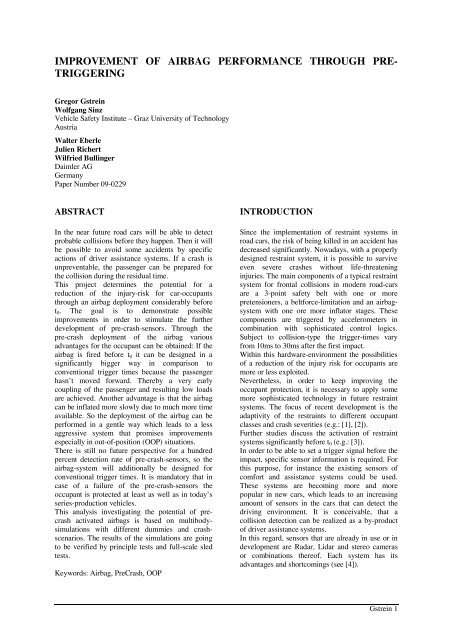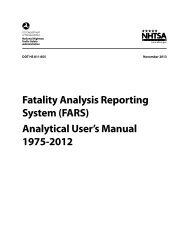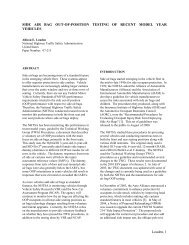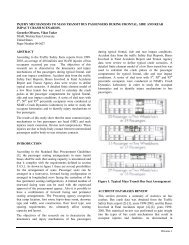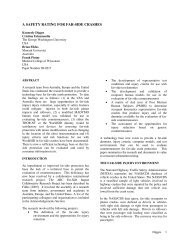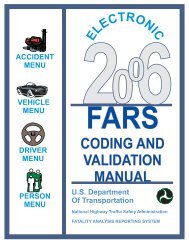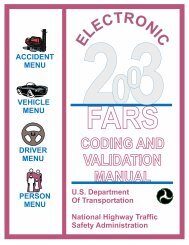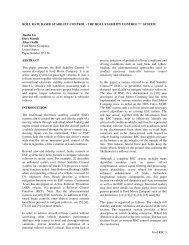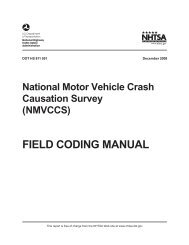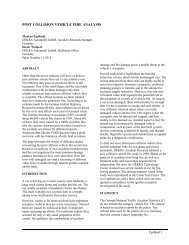improvement of airbag performance through pre- triggering
improvement of airbag performance through pre- triggering
improvement of airbag performance through pre- triggering
You also want an ePaper? Increase the reach of your titles
YUMPU automatically turns print PDFs into web optimized ePapers that Google loves.
IMPROVEMENT OF AIRBAG PERFORMANCE THROUGH PRE-<br />
TRIGGERING<br />
Gregor Gstrein<br />
Wolfgang Sinz<br />
Vehicle Safety Institute – Graz University <strong>of</strong> Technology<br />
Austria<br />
Walter Eberle<br />
Julien Richert<br />
Wilfried Bullinger<br />
Daimler AG<br />
Germany<br />
Paper Number 09-0229<br />
ABSTRACT<br />
In the near future road cars will be able to detect<br />
probable collisions before they happen. Then it will<br />
be possible to avoid some accidents by specific<br />
actions <strong>of</strong> driver assistance systems. If a crash is<br />
un<strong>pre</strong>ventable, the passenger can be <strong>pre</strong>pared for<br />
the collision during the residual time.<br />
This project determines the potential for a<br />
reduction <strong>of</strong> the injury-risk for car-occupants<br />
<strong>through</strong> an <strong>airbag</strong> deployment considerably before<br />
t0. The goal is to demonstrate possible<br />
<strong>improvement</strong>s in order to stimulate the further<br />
development <strong>of</strong> <strong>pre</strong>-crash-sensors. Through the<br />
<strong>pre</strong>-crash deployment <strong>of</strong> the <strong>airbag</strong> various<br />
advantages for the occupant can be obtained: If the<br />
<strong>airbag</strong> is fired before t0 it can be designed in a<br />
significantly bigger way in comparison to<br />
conventional trigger times because the passenger<br />
hasn’t moved forward. Thereby a very early<br />
coupling <strong>of</strong> the passenger and resulting low loads<br />
are achieved. Another advantage is that the <strong>airbag</strong><br />
can be inflated more slowly due to much more time<br />
available. So the deployment <strong>of</strong> the <strong>airbag</strong> can be<br />
performed in a gentle way which leads to a less<br />
aggressive system that promises <strong>improvement</strong>s<br />
especially in out-<strong>of</strong>-position (OOP) situations.<br />
There is still no future perspective for a hundred<br />
percent detection rate <strong>of</strong> <strong>pre</strong>-crash-sensors, so the<br />
<strong>airbag</strong>-system will additionally be designed for<br />
conventional trigger times. It is mandatory that in<br />
case <strong>of</strong> a failure <strong>of</strong> the <strong>pre</strong>-crash-sensors the<br />
occupant is protected at least as well as in today’s<br />
series-production vehicles.<br />
This analysis investigating the potential <strong>of</strong> <strong>pre</strong>crash<br />
activated <strong>airbag</strong>s is based on multibodysimulations<br />
with different dummies and crashscenarios.<br />
The results <strong>of</strong> the simulations are going<br />
to be verified by principle tests and full-scale sled<br />
tests.<br />
Keywords: Airbag, PreCrash, OOP<br />
INTRODUCTION<br />
Since the implementation <strong>of</strong> restraint systems in<br />
road cars, the risk <strong>of</strong> being killed in an accident has<br />
decreased significantly. Nowadays, with a properly<br />
designed restraint system, it is possible to survive<br />
even severe crashes without life-threatening<br />
injuries. The main components <strong>of</strong> a typical restraint<br />
system for frontal collisions in modern road-cars<br />
are a 3-point safety belt with one or more<br />
<strong>pre</strong>tensioners, a beltforce-limitation and an <strong>airbag</strong>system<br />
with one ore more inflator stages. These<br />
components are triggered by accelerometers in<br />
combination with sophisticated control logics.<br />
Subject to collision-type the trigger-times vary<br />
from 10ms to 30ms after the first impact.<br />
Within this hardware-environment the possibilities<br />
<strong>of</strong> a reduction <strong>of</strong> the injury risk for occupants are<br />
more or less exploited.<br />
Nevertheless, in order to keep improving the<br />
occupant protection, it is necessary to apply some<br />
more sophisticated technology in future restraint<br />
systems. The focus <strong>of</strong> recent development is the<br />
adaptivity <strong>of</strong> the restraints to different occupant<br />
classes and crash severities (e.g.: [1], [2]).<br />
Further studies discuss the activation <strong>of</strong> restraint<br />
systems significantly before t0 (e.g.: [3]).<br />
In order to be able to set a trigger signal before the<br />
impact, specific sensor information is required. For<br />
this purpose, for instance the existing sensors <strong>of</strong><br />
comfort and assistance systems could be used.<br />
These systems are becoming more and more<br />
popular in new cars, which leads to an increasing<br />
amount <strong>of</strong> sensors in the cars that can detect the<br />
driving environment. It is conceivable, that a<br />
collision detection can be realized as a by-product<br />
<strong>of</strong> driver assistance systems.<br />
In this regard, sensors that are already in use or in<br />
development are Radar, Lidar and stereo cameras<br />
or combinations there<strong>of</strong>. Each system has its<br />
advantages and shortcomings (see [4]).<br />
Gstrein 1
The existing sensor information can be used to<br />
foresee possible collisions and set actions in order<br />
to <strong>pre</strong>vent the accident and “<strong>pre</strong>pare” the occupants<br />
for the impact. There are, for example, already cars<br />
on the road, in which reversible restraint systems<br />
(e.g.: reversible belt-<strong>pre</strong>tensioner, [5]) are<br />
activated.<br />
This study discusses the activation <strong>of</strong> an<br />
irreversible restraint system (frontal passenger<br />
<strong>airbag</strong>). The goal is to work out the potential for<br />
reducing the injury risk as well as to discuss the<br />
shortcomings <strong>of</strong> such systems.<br />
Which beneficial characteristics can be expected <strong>of</strong><br />
an <strong>airbag</strong>-system that can be activated significantly<br />
before t0?<br />
Firstly, the passenger hasn’t moved forward prior<br />
to the impact, which makes it possible to design a<br />
bigger cushion in comparison to conventional<br />
trigger times. The bigger <strong>airbag</strong> leads to an earlier<br />
coupling <strong>of</strong> the passenger to the chassis-movement.<br />
This results in lower mean loads.<br />
Secondly, the loads on the dummy coming from the<br />
<strong>airbag</strong> affect a bigger surface and therefore are<br />
<strong>pre</strong>ferable to the more local loads <strong>of</strong> the safety belt.<br />
The share <strong>of</strong> the <strong>airbag</strong> on the total restraint-forces<br />
can be higher in a <strong>pre</strong>-crash-activated <strong>airbag</strong>system.<br />
Thirdly, due to the very early <strong>triggering</strong>, the<br />
cushion can be inflated much more slowly and in<br />
that way more gently in comparison to<br />
conventional trigger methods. This circumstance<br />
promises a considerable reduction <strong>of</strong> the injury risk<br />
for the car occupant in the so-called OOPsituations.<br />
Before these advantages and potential benefits for<br />
the passenger-safety in frontal collisions can be<br />
exploited in a series-vehicle, some nowadays still<br />
insuperable problems have to be resolved.<br />
Whereas a faulty activation <strong>of</strong> a reversible restraint<br />
system (e.g.: reversible belt-<strong>pre</strong>tensioner) is not<br />
quite problematical, it can be very dangerous if, for<br />
instance, an <strong>airbag</strong> deploys due to a malfunction <strong>of</strong><br />
a sensor system. The problem is that there is an<br />
endless number <strong>of</strong> possible crash-constellations in<br />
road traffic and the sensor systems are not yet, and<br />
won’t be able in the foreseeable future, to inter<strong>pre</strong>t<br />
every constellation correctly. So a compromise<br />
between detection-rate and detection-certainty has<br />
to be found. Keeping in mind the risk that<br />
implicates a faulty activation, it is reasonable not to<br />
deploy the <strong>airbag</strong> in case the sensors cannot<br />
definitely inter<strong>pre</strong>t the traffic situation.<br />
That leads to another problematic issue. The less<br />
accident-constellations can be detected correctly<br />
and as a consequence the <strong>airbag</strong> can be triggered<br />
before the impact, the more important remains a<br />
backup-strategy. If the sensor-system was able to<br />
recognize 95 percent <strong>of</strong> all possible accidentscenarios<br />
only the residual 5 percent would need a<br />
backup-strategy in terms <strong>of</strong> an alternative<br />
activation <strong>of</strong> the restraint systems. The problem is<br />
that the importance <strong>of</strong> the backup is more or less<br />
opposing the potential <strong>of</strong> the <strong>pre</strong>-crash-activation<br />
<strong>of</strong> the restraint systems since it directly affects the<br />
possible <strong>airbag</strong>-size.<br />
Methodology<br />
The idea was, to elaborate a completely new <strong>pre</strong>crash<br />
<strong>airbag</strong> system for an existing road car for the<br />
frontal passenger. Comparing the results with the<br />
<strong>performance</strong> <strong>of</strong> the existing series <strong>airbag</strong> system<br />
the potential for injury-reduction should be<br />
illustrated.<br />
Therefore some boundary conditions for the<br />
development <strong>of</strong> this new <strong>pre</strong>-crash <strong>airbag</strong> were set<br />
up:<br />
- The earliest possible trigger-time is 80ms prior to<br />
the first contact.<br />
- A “backup” has to be considered. In the case <strong>of</strong> a<br />
non-detection <strong>of</strong> the <strong>pre</strong>-crash-sensors, the system<br />
has to work with conventional trigger-times as<br />
well. In this case, the injury risk for the passenger<br />
must not be higher than it is with the conventional<br />
<strong>airbag</strong>-system.<br />
- The <strong>airbag</strong> system must not be designed for just<br />
one single loading condition, in order to allow an<br />
impartial comparison to the series production status<br />
which is a compromise for many load cases.<br />
Therefore the new <strong>airbag</strong> system has to be designed<br />
for different dummy-sizes and accident-types.<br />
More <strong>pre</strong>cisely, it has to fulfill partly opposing<br />
requirements <strong>of</strong> the 5 th percentile female, 50 th<br />
percentile and 95 th percentile male dummies in the<br />
Euro NCAP, US-NCAP crash test-scenario.<br />
Furthermore the unbelted FMVSS208 crash test<br />
has to be taken into account.<br />
- As this study is not only theoretical but also<br />
consists <strong>of</strong> an experimental validation <strong>of</strong> the<br />
simulation results, the hardware package must be<br />
“realizable”.<br />
Within these limitations viable parameter<br />
configurations for the different dummy/loadcasecombinations<br />
were developed, using the<br />
multibody-simulation-tool MADYMO. The results<br />
are going to be validated exemplarily by sled tests<br />
during autumn 2009. The <strong>performance</strong> in terms <strong>of</strong><br />
OOP has already been demonstrated and the results<br />
are discussed later on.<br />
Definitions<br />
With respect to the timeline, two scenarios have to<br />
be distinguished: On the one hand, we have the<br />
<strong>pre</strong>-collision activation <strong>of</strong> the restraint systems at<br />
the earliest <strong>of</strong> 80ms before the impact. As<br />
mentioned before also a “backup”-strategy is<br />
necessary in case <strong>of</strong> a malfunction <strong>of</strong> the <strong>pre</strong>-crashsensors.<br />
So the second scenario consists <strong>of</strong> the<br />
activation <strong>of</strong> the same hardware components with<br />
conventional trigger-systems. This leads to a big<br />
Gstrein 2
difference in time available for the deployment <strong>of</strong><br />
the <strong>airbag</strong> which makes an adaptivity <strong>of</strong> the<br />
inflation inevitable.<br />
As a first step different hardware packages were<br />
evaluated with respect to their anticipatory<br />
compliance to the set requirements. The discussed<br />
hardware components were the inflator, the <strong>airbag</strong>shape<br />
and the vent-holes.<br />
As mentioned before, one boundary condition was<br />
the feasibility <strong>of</strong> the hardware package. Keeping<br />
this in mind, the most promising variant is made up<br />
<strong>of</strong> an inflator with three stages and two <strong>airbag</strong>shapes<br />
that can be transformed into each other for<br />
example by releasing tethers. Furthermore the<br />
<strong>airbag</strong> features an active vent and a vent hole that<br />
opens as soon as the <strong>airbag</strong> <strong>pre</strong>ssure exceeds a<br />
certain limit.<br />
Each one <strong>of</strong> the two <strong>airbag</strong>-shapes is designed to fit<br />
a specific dummy type. The smaller cushion (~90l)<br />
is deployed for the 5 th percentile female dummy,<br />
while the bigger <strong>airbag</strong>-shape (~120l) fits for the<br />
two other dummies (50 th - and 95 th -percentile male).<br />
Obviously you can gain more potential for lower<br />
injury risk when bigger <strong>airbag</strong>s are used, but then<br />
you’ll have to face the following problems in the<br />
backup-scenario. Firstly you have to inflate a<br />
bigger volume within a very short time which leads<br />
to a more aggressive inflator-characteristic. And<br />
secondly you run a higher risk, that the deploying<br />
<strong>airbag</strong> hits the passenger.<br />
The two <strong>airbag</strong>-shapes have to be filled by the three<br />
stages <strong>of</strong> the inflator. Stage I and stage III are<br />
designed to blow up the 90l-<strong>airbag</strong> to operating<br />
<strong>pre</strong>ssure, stage I in a time <strong>of</strong> 120ms and stage III in<br />
40ms. Subject to the trigger-scenario the required<br />
stage is fired. If the 120l-<strong>airbag</strong> has to be deployed,<br />
stage II is activated additionally in order to fill up<br />
the bigger volume to operating <strong>pre</strong>ssure. The<br />
<strong>pre</strong>ssure dependent standard vent hole is necessary<br />
in order to avoid massive gas-loss during the long<br />
lasting deployment <strong>of</strong> the <strong>airbag</strong> in case <strong>of</strong> a <strong>pre</strong>collision<br />
activation.<br />
The selected hardware components allow a high<br />
number <strong>of</strong> possible combinations for the different<br />
load cases and dummies. In the following, the most<br />
promising processing strategies are <strong>pre</strong>sented<br />
qualitatively:<br />
PreCrash-Scenario:<br />
PreCrash-sensors foresee an upcoming collision<br />
and 80ms before the impact the <strong>airbag</strong> is triggered.<br />
For the 50 th - and the 95 th -percentile male dummy<br />
inflator-stage I slowly deploys the big cushion<br />
(BagShape 1; ~120l). After a specific time, that<br />
depends on the load-case and whether it is a 50 th -<br />
or 95 th -percentile dummy, inflator-stage II is<br />
activated in order to fill up the <strong>airbag</strong> to operating<br />
<strong>pre</strong>ssure. After a certain time the active vent is<br />
triggered to allow more dummy-movement making<br />
thereby best use <strong>of</strong> the space available. The trigger-<br />
times for inflator-stage II and the active vent vary<br />
subject to dummy and load case, as can be seen in<br />
the following figure (diagonally hatched <br />
deploying <strong>airbag</strong>; cross hatch <strong>airbag</strong> is<br />
positioned and ready to restraint):<br />
Infl. Stage I<br />
Infl. Stage II<br />
Infl. Stage III<br />
50 th - 95 th -percentile Dummy, PreCrash<br />
BagShape 1 (~120l)<br />
BagShape 2 (~90l)<br />
Active Vent<br />
t [ms] -80 -40 0 40 80 120<br />
Figure 1: Deployment logics for the 50 th - and<br />
95 th -percentile male dummy - PreCrash<br />
It seems to be reasonable to work out adapted<br />
strategies in terms <strong>of</strong> trigger-timing and vent<br />
opening for both the 50 th - and the 95 th -percentile<br />
male dummy, in order to reduce the injury risk as<br />
much as possible.<br />
Also for the 5 th -percentile female, the <strong>airbag</strong> is<br />
activated by <strong>pre</strong>-crash-sensors 80ms prior to the<br />
collision. For approximately 120ms the small<br />
cushion (BagShape 2; ~90l) deploys gently and<br />
gets in position around 40ms after the impact, the<br />
time when the occupant begins his/her forward<br />
movement. Since the <strong>airbag</strong>-shape for the 5 th -<br />
percentile female dummy has less volume, stage I<br />
fills the cushions sufficiently. In order to keep the<br />
restraint-loads below the biomechanical limits <strong>of</strong><br />
small, lightweight persons it is necessary to<br />
activate the active vent early. The timing for ventopening<br />
depends on the load-case. Figure 2<br />
illustrates the setup <strong>of</strong> the <strong>airbag</strong> system for the 5 th -<br />
percentile woman in one specific loading<br />
condition:<br />
Infl. Stage I<br />
Infl. Stage II<br />
Infl. Stage III<br />
BagShape 1 (~120l)<br />
BagShape 2 (~90l)<br />
Active Vent<br />
5 th -percentile Dummy, PreCrash<br />
t [ms] -80 -40 0 40 80 120<br />
Figure 2: Deployment logics for the 5 th -<br />
percentile female dummy - PreCrash<br />
Backup-Scenario:<br />
For any reason the <strong>pre</strong>-crash-sensors were not able<br />
to detect the collision and the conventional triggersystem<br />
has to set the trigger-time for the restraint<br />
systems. In this case it is essential to deploy the<br />
<strong>airbag</strong> as fast as possible in order not to lose<br />
deceleration-space.<br />
Gstrein 3
So for the 50 th - and 95 th -percentile male dummy<br />
inflator stages II and III are fired at the same time.<br />
Around 40ms after the impact the <strong>airbag</strong> cushion is<br />
positioned and able to take restraint loads. Subject<br />
to crash-scenario and dummy-weight the active<br />
vent is opened at a specific time after the impact.<br />
Infl. Stage I<br />
Infl. Stage II<br />
Infl. Stage III<br />
50 th - 95 th -percentile Dummy, Backup<br />
BagShape 1 (~120l)<br />
BagShape 2 (~90l)<br />
Active Vent<br />
t [ms] -80 -40 0 40 80 120<br />
Figure 3: Deployment logics for the 50 th - and<br />
95 th -percentile male dummy - Backup<br />
Equivalent considerations need to be done also for<br />
the 5 th -percentile female dummy. In this case only<br />
stage II <strong>of</strong> the <strong>airbag</strong> inflator is activated at<br />
conventional trigger-times. Within a very short<br />
time the cushion is positioned and able to restrain<br />
the passenger. Subject to the crash-scenario, the<br />
active vent has to be opened early in order to avoid<br />
too high loads on the occupant.<br />
Infl. Stage I<br />
Infl. Stage II<br />
Infl. Stage III<br />
BagShape 1 (~120l)<br />
BagShape 2 (~90l)<br />
Active Vent<br />
5 th -percentile Dummy, Backup<br />
t [ms] -80 -40 0 40 80 120<br />
Figure 4: Deployment logics for the 5 th -<br />
percentile female dummy - Backup<br />
The earlier specified deployment strategies have a<br />
direct impact onto the geometry <strong>of</strong> the <strong>airbag</strong>cushion.<br />
The development <strong>of</strong> the two required<br />
<strong>airbag</strong>-shapes is discussed in the following:<br />
Airbag Geometry<br />
The highest potential for reducing the injury risk by<br />
a <strong>pre</strong>-crash-activation <strong>of</strong> an <strong>airbag</strong>-system results in<br />
an optimized shape. If the <strong>airbag</strong> is fired<br />
considerably before the impact the passenger<br />
doesn’t move forward during the deployment. So<br />
the shape can be designed with more extension in<br />
the longitudinal direction <strong>of</strong> the car, closer towards<br />
the occupant.<br />
If the person is decelerated within a longer<br />
distance, the mean loads decrease proportionally.<br />
So an earlier coupling <strong>of</strong> the dummy to the chassismovement<br />
can reduce the injury risk significantly.<br />
In order to make best benefit <strong>of</strong> this circumstance it<br />
is necessary to provide an <strong>airbag</strong> shape that s<strong>pre</strong>ads<br />
the restraint loads evenly to a surface as big as<br />
possible. Also large gaps between the dummy-head<br />
and the cushion should be avoided, to ensure the<br />
early coupling and evade load peaks.<br />
In order to achieve, that the <strong>airbag</strong> can apply<br />
restraint loads onto the passenger from the very<br />
first forward movement, some design criteria have<br />
to be fulfilled. The cushion has to contact the<br />
occupant evenly on the thorax and the thighs.<br />
Furthermore it is necessary that the cushion<br />
supports itself on the instrument panel (IP) and the<br />
windscreen. If there is some space between the<br />
deployed <strong>airbag</strong> and the IP, the person will push<br />
the <strong>airbag</strong> forwards until it contacts the dashboard.<br />
The distance lost here leads to increasing loads on<br />
the dummy.<br />
Figure 5 highlights the areas, where the <strong>airbag</strong><br />
needs to brace in order to be able to build up<br />
effective restraint forces.<br />
Figure 5: Design criteria for a well working<br />
<strong>pre</strong>crash-<strong>airbag</strong><br />
As mentioned above, for this study it was necessary<br />
to design a dual-stage <strong>airbag</strong>-system. The chosen<br />
deployment-strategy made it inevitable to put quite<br />
some emphasis on the backup-scenario. Therefore<br />
the <strong>airbag</strong>-volumes are comparable to a<br />
conventionally triggered series-vehicle <strong>airbag</strong><br />
which in shape and volume re<strong>pre</strong>sents an optimized<br />
compromise for many loading conditions. Another<br />
point that has to be taken into account is, that the<br />
bigger the <strong>airbag</strong> volume is, the higher the inflation<br />
mass flow has to be in order to fill the cushion<br />
sufficiently in the backup-scenario. That leads to a<br />
more aggressive deployment <strong>of</strong> the <strong>airbag</strong> and<br />
possible problems in OOP-situations.<br />
Due to these reasons the goal <strong>of</strong> <strong>airbag</strong>-design was<br />
to achieve more extension <strong>of</strong> the cushion in the<br />
longitudinal direction <strong>of</strong> the car, without a dramatic<br />
increase <strong>of</strong> the volume. As the <strong>airbag</strong> always tries<br />
to assume a more or less spherical form, the longer<br />
you design it, the wider it gets, and the volume<br />
basically increases with the power <strong>of</strong> three. For that<br />
reason it appeared to be necessary to provide an<br />
internal transversal tether for the <strong>airbag</strong>-shape for<br />
Gstrein 4
the 50 th - and 95 th -percentile dummy. In the left<br />
image <strong>of</strong> Figure 6, the transversal tether can be<br />
seen.<br />
transversal<br />
tether<br />
Figure 6: Airbag-shapes for different dummies<br />
Furthermore additional tethers are necessary to<br />
realize two <strong>airbag</strong>-shapes out <strong>of</strong> one cushion.<br />
Initially the tethers are constrained in any case and<br />
the small <strong>airbag</strong>-shape for the 5 th -percentile female<br />
dummy is deployed. A system, that is able to<br />
classify the passenger (e.g.: by weight or by seating<br />
position) gives the signal that the bigger shape is<br />
necessary and the tethers are released by an<br />
actuator.<br />
Inflator-Requirements<br />
At the beginning <strong>of</strong> this study it was not clear, with<br />
which hardware the slow deployment <strong>of</strong> the <strong>airbag</strong><br />
could be realized. It turned out to be quite difficult<br />
to find available inflators which were able to<br />
provide a gas flow-characteristic that would fill up<br />
the cushion in approximately 120ms.<br />
So for a first step, generic mass flow-curves were<br />
assumed. In a further simulation-loop before the<br />
validation tests these characteristics are going to be<br />
substituted by measured properties <strong>of</strong> the inflators<br />
that are going to be applied in the tests. In Figure 7<br />
the generic mass flow curves <strong>of</strong> the different<br />
inflator-stages are illustrated.<br />
The principal idea was to use an inflator with three<br />
stages, where each stage has a specific “function”.<br />
One stage (Stage I) is necessary for the slow, gentle<br />
deployment <strong>of</strong> the cushion in a case <strong>of</strong> a <strong>pre</strong>collision<br />
activation. This stage is capable <strong>of</strong> filling<br />
the bag-shape <strong>of</strong> the 5 th -percentile female dummy<br />
up to operating <strong>pre</strong>ssure.<br />
Figure 7: generic mass flow-characteristics <strong>of</strong><br />
the three gas-generator stages<br />
If the <strong>airbag</strong>-shape for the 50 th - and 95 th -percentile<br />
male dummies is deployed, the bigger volume<br />
cannot be filled sufficiently with stage I. So it is<br />
necessary to trigger an additional inflator-stage<br />
(Stage II) that delivers enough gas to reach the<br />
operating <strong>pre</strong>ssure. The timing for the deployment<br />
<strong>of</strong> stage II depends on the load-case and the<br />
dummy-size. The goal is that the <strong>airbag</strong> is fully<br />
inflated, positioned and ready to take restraint loads<br />
as soon as the forward movement <strong>of</strong> the passenger<br />
begins.<br />
If the <strong>pre</strong>-crash sensors don’t work correctly, the<br />
trigger-signal for the <strong>airbag</strong> is set by conventional<br />
sensor systems. In this case it is crucial that the<br />
<strong>airbag</strong> is deployed as fast as possible since valuable<br />
time has already been lost for the detection <strong>of</strong> the<br />
impact. Therefore stage III <strong>of</strong> the inflator is capable<br />
<strong>of</strong> filling the small cushion for the 5 th -percentile<br />
female dummy rapidly, within around 35<br />
milliseconds. This <strong>performance</strong> corresponds<br />
roughly to typical today’s inflators. Analogously to<br />
the <strong>pre</strong>-crash activation, if the bigger <strong>airbag</strong>-shape<br />
for the 50 th - and 95 th -percentile male dummy is<br />
deployed, it is necessary to fire inflator stage II<br />
additionally.<br />
One further aspect has to be taken into account:<br />
Stage I should be used for the OOP-tests <strong>of</strong> the USregulatory<br />
requirements because the slow inflation<br />
promises significant <strong>improvement</strong>s. Therefore it is<br />
necessary that the onset <strong>of</strong> the inflator is designed<br />
moderately.<br />
In-Crash-Potential<br />
As discussed before, the earlier coupling <strong>of</strong> the<br />
passenger to the chassis-movement due to an<br />
optimized <strong>airbag</strong> shape promises the biggest<br />
reduction <strong>of</strong> injury risk. A further advantage <strong>of</strong><br />
quenching the passenger with the <strong>airbag</strong> instead <strong>of</strong><br />
the seatbelt is that a big surface <strong>of</strong> the person is<br />
affected. The risk for fractures <strong>of</strong> the clavicle or<br />
abdominal injuries that can result from the high<br />
local loads <strong>of</strong> the seatbelt is reduced.<br />
These two potential benefits <strong>of</strong> a <strong>pre</strong>-collision<br />
activated restraint system should be realized as well<br />
Gstrein 5
as possible, when the scenarios mentioned<br />
beforehand were elaborated.<br />
The job to adjust the hardware components<br />
properly for the three frontal load cases (US-<br />
NCAP, Euro NCAP and FMVSS208, unbelted) and<br />
the three dummy-sizes (5 th -percentile female, 50 th -<br />
and 95 th -percentile male) at two completely<br />
different trigger-scenarios turned out to be very<br />
challenging. The parameters to be varied were:<br />
1. diameter base vent<br />
2. diameter active vent<br />
3. timing active vent<br />
4. <strong>performance</strong> <strong>of</strong> inflator stage I<br />
5. <strong>performance</strong> <strong>of</strong> inflator stage II<br />
6. <strong>performance</strong> <strong>of</strong> inflator stage III<br />
7. timing inflator stage I<br />
8. timing inflator stage II<br />
9. timing inflator stage III<br />
The high number <strong>of</strong> possible combinations made it<br />
necessary to apply a systematic variation <strong>of</strong> the<br />
influencing parameters. In this regard, the program<br />
modeFrontier was a useful tool for the <strong>pre</strong>paration<br />
<strong>of</strong> the DOE-tables and for the illustration <strong>of</strong> the<br />
effect <strong>of</strong> the single influencing factors.<br />
With the found set <strong>of</strong> parameters it cannot be<br />
claimed that the very best solution has been worked<br />
out. Therefore it would have been necessary to run<br />
many iteration loops, which have not been<br />
performed in this study. In this phase <strong>of</strong> the<br />
analysis, the goal was to elaborate a good working<br />
configuration as a basis for demonstrating the<br />
principal potential for a reduction <strong>of</strong> the injury risk.<br />
In the following, the specific problems <strong>of</strong> the two<br />
trigger-scenarios and the results <strong>of</strong> the simulations<br />
are going to be discussed:<br />
Simulation results: Backup-Scenario<br />
Since the requirement has been set, that the injury<br />
risk in the backup-strategy must not be higher than<br />
it is in the series-vehicle, this scenario was the<br />
starting point for the development <strong>of</strong> the <strong>airbag</strong><br />
system. The <strong>performance</strong>s <strong>of</strong> the single stages <strong>of</strong><br />
the inflator were the first hardware parameters,<br />
which were freezed. As mentioned earlier, stage III<br />
is designed to fill up the smaller <strong>airbag</strong> size<br />
(BagShape 2, ~90l) to operating <strong>pre</strong>ssure. Stage II<br />
provides the additionally required gas mass to fill<br />
up the bigger <strong>airbag</strong> size (BagShape 1, ~120l)<br />
sufficiently. Once the inflator was set, suitable<br />
vent-diameters were elaborated. The diameter <strong>of</strong><br />
the base-vent is mainly driven by the heavy 95 th -<br />
percentile male dummy in the unbelted FMVSS208<br />
load case. Comparable restraint <strong>performance</strong> could<br />
also be achieved with bigger vents and<br />
corresponding increased inflator <strong>performance</strong>, but<br />
the goal was to get along with the lowest possible<br />
inflator power.<br />
The diameter <strong>of</strong> the active vent is primarily set by<br />
the forward movement <strong>of</strong> the 5 th -percentile female<br />
dummy in the US-NCAP-loading condition. All the<br />
other dummy-loading-combinations must be<br />
covered with an adapted timing <strong>of</strong> the single stages<br />
and the active vent.<br />
The simulation results <strong>of</strong> the backup-scenario are<br />
<strong>pre</strong>sented on behalf <strong>of</strong> the 50 th -percentile male<br />
dummy, beginning with the Euro NCAP loading<br />
condition:<br />
The charts in Figure 8 give an overview <strong>of</strong> selected<br />
injury criteria comparing the conventional <strong>airbag</strong><br />
deployment <strong>of</strong> the series vehicle and the results <strong>of</strong><br />
the backup-scenario. It stands out, that especially<br />
the loads on the head are reduced significantly<br />
whereas the loads on chest and pelvis remain<br />
roughly unchanged.<br />
Figure 8: simulation results: 50 th -percentile<br />
male dummy, Euro NCAP<br />
In Figure 9 the timeline <strong>of</strong> the head-acceleration<br />
illustrates the tremendous reduction <strong>of</strong> the peak<br />
value to less than half <strong>of</strong> the reference. Due to the<br />
adapted <strong>airbag</strong>-shape, the head contacts the cushion<br />
earlier. Furthermore the resulting inflation-power<br />
<strong>of</strong> the two concurrently fired inflator stages II and<br />
III is significantly higher than the series-vehicle<br />
inflator. As a result, the cushion deploys faster, and<br />
imposes restraint loads onto the dummy earlier.<br />
Finally the properly adjusted trigger timing <strong>of</strong> the<br />
active vent allows the torso more forward<br />
movement, whereby the available space for<br />
deceleration can be exploited optimally. All these<br />
circumstances lead to the almost ideal rectangular<br />
form <strong>of</strong> the head acceleration.<br />
Gstrein 6
Figure 9: time line <strong>of</strong> the head acceleration <strong>of</strong><br />
the 50 th -percentile male dummy, Euro NCAP<br />
In Figure 10 the time dependent characteristic <strong>of</strong><br />
the thorax acceleration is shown. The slight peak at<br />
about 50 ms after t0 results in the fast deploying<br />
<strong>airbag</strong> that contacts the dummy with a high relative<br />
velocity. This is a consequence <strong>of</strong> the compromise<br />
in the <strong>airbag</strong> geometry. It is designed closer<br />
towards the passenger in order to arise potential for<br />
reduced injury risk in a <strong>pre</strong>-crash activation. The<br />
peak value <strong>of</strong> the thorax acceleration and the time<br />
point, when it occurs is more or less equivalent to<br />
the series vehicle.<br />
Figure 10: time line <strong>of</strong> the thorax acceleration <strong>of</strong><br />
the 50 th -percentile male dummy, Euro NCAP<br />
The pelvis acceleration shows similar<br />
characteristics as shown in Figure 11. The review<br />
<strong>of</strong> the animation-files <strong>of</strong> the simulation pointed out,<br />
that the peak in the acceleration curves <strong>of</strong> thorax<br />
and pelvis at around 100ms after t0 has two origins.<br />
Firstly at this time the torso penetrates the seat<br />
cushion at most which indicates high loads in the<br />
pelvis-z-direction. Secondly, the knees contact the<br />
dashboard, which leads to a high load in the pelvisx-direction.<br />
As these two effects are mainly<br />
influenced by the lap belt, which has not been<br />
changed in comparison to the series vehicle,<br />
changes resulting from the new <strong>airbag</strong> system<br />
cannot be seen clearly.<br />
Figure 11: time line <strong>of</strong> the pelvis acceleration <strong>of</strong><br />
the 50 th -percentile male dummy, Euro NCAP<br />
In Figure 12 the effect <strong>of</strong> the faster deploying<br />
<strong>airbag</strong> in the backup scenario on the chest<br />
deflection can be detected. Until about 50 ms after<br />
t0, the <strong>pre</strong>tensioned seatbelt in combination with the<br />
dummy inertia leads to a slightly increasing chest<br />
deflection. Due to the earlier contact with the<br />
harder <strong>airbag</strong> cushion, the chest deflection<br />
increases considerably with respect to the<br />
reference, whereby the peak value is about four<br />
millimeters higher.<br />
Figure 12: time line <strong>of</strong> the chest deflection <strong>of</strong> the<br />
50 th -percentile male dummy, Euro NCAP<br />
The second scrutinized loading condition was the<br />
US-NCAP-rating crash test. Due to the<br />
configuration with the 100 percent overlap and the<br />
rigid barrier, this test is characterized by a<br />
significantly shorter duration and higher peak<br />
loads. Figure 13 illustrates the <strong>performance</strong> <strong>of</strong> the<br />
developed <strong>airbag</strong> system in the backup scenario. It<br />
can be seen, that the tendency is comparable to the<br />
Euro NCAP loading discussed beforehand. The risk<br />
for head injuries is reduced considerably whereas<br />
the loads onto thorax and pelvis remain more or<br />
less the same as in the series vehicle.<br />
Gstrein 7
Figure 13: simulation results: 50 th -percentile<br />
male dummy, US-NCAP<br />
Finally the US regulatory test FMVSS208 was<br />
analyzed. Since in the United States today the use<br />
<strong>of</strong> seatbelts is still not obligatory in all states, the<br />
regulations <strong>pre</strong>scribe a crash test without seatbelt.<br />
This test-configuration sets very specific demands<br />
onto the setup <strong>of</strong> the <strong>airbag</strong>-system.<br />
Although the test-speed is remarkably slower than<br />
it was in the two <strong>pre</strong>vious discussed crash tests, the<br />
risk that the dummy punches <strong>through</strong> to the<br />
dashboard is very high. The missing seat belt<br />
facilitates a rotation <strong>of</strong> the dummy since the pelvis<br />
is not braced into the seat by the lap belt. As a<br />
result <strong>of</strong> this rotation the head <strong>of</strong> the dummy can<br />
approach the windscreen and the dashboard very<br />
closely. Due to this, especially the heavy 95 th -<br />
percentile male dummy requires high inflator<br />
<strong>performance</strong> and small vents. Figure 14 gives an<br />
overview <strong>of</strong> simulation results <strong>of</strong> selected injury<br />
criteria:<br />
Figure 14: simulation results: 50 th -percentile<br />
male dummy, FMVSS208 (unbelted)<br />
Also in this case, the tendency is roughly the same<br />
whereas the chest deflection has increased<br />
considerably. The distance <strong>of</strong> the dummy head to<br />
the dashboard and the windscreen can be compared<br />
between the series vehicle and the developed<br />
backup-strategy.<br />
Simulation results: PreCrash -Scenario<br />
Most <strong>of</strong> the variables <strong>of</strong> the hardware package<br />
(<strong>performance</strong> <strong>of</strong> inflator stage II and III; vent<br />
diameters) have already been set in the backupscenario.<br />
Only the <strong>performance</strong> <strong>of</strong> stage I can be<br />
adjusted to get an optimum in the <strong>pre</strong>-crashscenario.<br />
In this context a specific problem <strong>of</strong> the<br />
slowly deploying <strong>airbag</strong> has to be taken into<br />
account. If the base-vent is open during the<br />
complete inflation time, a lot <strong>of</strong> gas is lost into the<br />
passenger compartment. This problem could be<br />
compensated by an increased capacity <strong>of</strong> the<br />
inflator, which has drawbacks referring to the size<br />
and weight <strong>of</strong> the <strong>airbag</strong>-module and the<br />
aggressiveness <strong>of</strong> the inflator. So it is reasonable to<br />
apply a vent that remains closed during the<br />
inflation and opens as soon as the <strong>airbag</strong> <strong>pre</strong>ssure<br />
increases due to the dummy contact. In order to<br />
provide sufficient restraint capacity for each<br />
combination <strong>of</strong> dummy and crash testconfiguration,<br />
a proper set <strong>of</strong> trigger time points<br />
has to be found.<br />
The simulation results <strong>of</strong> the <strong>pre</strong>crash-scenario are<br />
going to be <strong>pre</strong>sented by means <strong>of</strong> the 5 th -percentile<br />
female dummy. The tendencies <strong>of</strong> the results for<br />
the two male dummies are comparable, but due to<br />
its growing relevance in future regulations, the<br />
female dummy was selected. The first loading<br />
condition to analyze is the US-NCAP-Rating:<br />
Figure 15 gives an overview <strong>of</strong> selected injurycriteria.<br />
It demonstrates that especially the load on<br />
the head is considerably reduced. Furthermore the<br />
chest-acceleration has decreased slightly whereas<br />
the peaks <strong>of</strong> chest-deflection and pelvisacceleration<br />
have roughly remained unchanged.<br />
Figure 15: simulation results: 5 th -percentile<br />
female dummy, US-NCAP<br />
The time-dependent behavior <strong>of</strong> the head<br />
acceleration is shown in Figure 16. It can be seen,<br />
that the head contacts the cushion about 20 ms<br />
earlier than in the series vehicle. This leads to a<br />
rough bisection <strong>of</strong> the peak load on the head and to<br />
a tremendous reduction <strong>of</strong> the HIC-value.<br />
Gstrein 8
Figure 16: time line <strong>of</strong> the head acceleration <strong>of</strong><br />
the 5 th -percentile female dummy, US-NCAP<br />
Figure 17 and Figure 18 display the loads on the<br />
thorax <strong>of</strong> the dummy. It has to be kept in mind, that<br />
the thorax is not only affected by the restraint loads<br />
<strong>of</strong> the <strong>airbag</strong> but also by those <strong>of</strong> the seatbelt.<br />
The time line <strong>of</strong> the thorax acceleration shows, that<br />
in comparison to the head accelerations an earlier<br />
coupling <strong>of</strong> the chest to the <strong>airbag</strong>-cushion leads to<br />
reduced peak loads although the <strong>improvement</strong> is<br />
considerably smaller.<br />
Figure 17: time line <strong>of</strong> the thorax acceleration <strong>of</strong><br />
the 5 th -percentile female dummy, US-NCAP<br />
This effect unfortunately doesn’t apply to the chest<br />
deflection. Although the cushion imposes loads<br />
onto the dummy at an early stage, the peak load<br />
equals to the conventional system.<br />
Figure 18: time line <strong>of</strong> the chest deflection <strong>of</strong> the<br />
5 th -percentile female dummy, US-NCAP<br />
Unlike the head and the thorax, the pelvis is not<br />
braced by the <strong>airbag</strong> and so an earlier coupling<br />
cannot be seen. This effect could already be noticed<br />
in the backup-scenario.<br />
Figure 19: time line <strong>of</strong> the pelvis acceleration <strong>of</strong><br />
the 5 th -percentile female dummy, US-NCAP<br />
In Figure 19 it can be detected, that an <strong>airbag</strong> that<br />
is activated 80 milliseconds before t0 doesn’t have<br />
influence on the pelvis loads. In order to reduce the<br />
loads on the pelvis, changes at the belt system have<br />
to be considered.<br />
The second analyzed scenario is the Euro NCAPfrontal<br />
crash test: In comparison to the US-NCAPrating,<br />
the Euro NCAP is performed with a<br />
deformable barrier and only 40 percent overlap.<br />
This leads to an about 50 percent longer impactduration<br />
within which the occupant has to be<br />
restrained properly. This circumstance entails some<br />
problems in the timing adjustment. In order to<br />
evade, that the dummy punches <strong>through</strong> the <strong>airbag</strong><br />
and contacts the dashboard, the active vent has to<br />
be opened very late. The drawback <strong>of</strong> this solution<br />
is that it leads to a more “triangular” shape <strong>of</strong> the<br />
acceleration curves, which is undesirable.<br />
Alternatively to the late opening <strong>of</strong> the active vent,<br />
the inflator can be triggered later. This variant has<br />
the effect, that the inflator still delivers gas, when<br />
the occupant is already moving forward and so the<br />
cushion is “harder” at an early stage <strong>of</strong> the impact.<br />
For the Euro NCAP loading condition it turned out<br />
to be advantageous to fire inflator stage I about 60<br />
milliseconds before t0. The simulation results for<br />
this configuration are illustrated in Figure 20:<br />
It can be seen, that the tendency is similar to the<br />
above mentioned US-NCAP-loading. The risk for<br />
head injuries is reduced significantly, whereas the<br />
other injury criteria remain roughly unchanged.<br />
Gstrein 9
Figure 20: simulation results: 5 th -percentile<br />
female dummy, Euro NCAP<br />
The third investigated loading condition was the<br />
unbelted US legal test FMVSS208 with its specific<br />
requirements. Figure 21 shows the simulation<br />
results <strong>of</strong> the 5 th -percentile female dummy.<br />
It can be observed, that in comparison to the two<br />
belted load cases, the reduction <strong>of</strong> the thoraxacceleration<br />
is remarkably better. Since there is no<br />
seatbelt, this load case shows only the impact <strong>of</strong> the<br />
two different <strong>airbag</strong>-systems onto the thorax load.<br />
The other injury criteria show the same behavior as<br />
before.<br />
Figure 21: simulation results: 5 th -percentile<br />
female dummy, FMVSS208 (unbelted)<br />
During autumn 2009 the <strong>pre</strong>sented simulation<br />
results are going to be validated exemplarily by<br />
means <strong>of</strong> sled tests. Afterwards, another simulation<br />
loop is planned in order to improve the simulation<br />
model and increase its <strong>pre</strong>dictive capacity. After a<br />
further optimization loop, more impartial<br />
conclusions about the potential <strong>of</strong> <strong>pre</strong>-crash<br />
activated restraint systems can be drawn.<br />
Test result: OOP-Potential<br />
Since 2003 the US-regulation FMVSS208 has<br />
required the consideration <strong>of</strong> different OOPsituations<br />
in the development <strong>of</strong> the <strong>airbag</strong> system.<br />
It is up to the OEM whether the <strong>airbag</strong> is activated<br />
or not when a child is seated on the passenger seat,<br />
or in case it stands out <strong>of</strong> position. Another<br />
possibility is the so-called low risk deployment <strong>of</strong><br />
the <strong>airbag</strong> whereby the inflator is fired with<br />
reduced power. Since the sensors for the detection<br />
<strong>of</strong> the position <strong>of</strong> the car occupant are still in<br />
development (e.g.: [6]), the low risk deployment is<br />
commonly applied nowadays. To reduce the loads<br />
on the dummy in these OOP-tests special cushion<br />
folding methods (e.g.: [7]) were developed and<br />
inflators were tuned to provide a gentle onset.<br />
As mentioned earlier, another potential<br />
<strong>improvement</strong> <strong>of</strong> an <strong>airbag</strong>-system that is deployed<br />
significantly before t0 is, to inflate the cushion<br />
more slowly and in this way with reduced<br />
aggressiveness. The problem is that this effect<br />
cannot be foreseen certainly, because the influence<br />
<strong>of</strong> the <strong>airbag</strong>-door in the dashboard on the<br />
deployment <strong>of</strong> the <strong>airbag</strong> is not clear. In the worst<br />
case, the slowly deploying cushion doesn’t have<br />
the necessary initial “punch” to open the door.<br />
Then the <strong>airbag</strong> would possibly deploy within the<br />
dashboard. Another scenario is that the <strong>airbag</strong>-door<br />
doesn’t open due to the initial “punch”. It opens<br />
later as a result <strong>of</strong> the rapidly increasing bag<strong>pre</strong>ssure<br />
and the <strong>airbag</strong> deploys with even more<br />
power. This circumstance can possibly lead to<br />
worse OOP-results. In order to clarify this issue, it<br />
needed to be analyzed.<br />
The used simulation-model <strong>of</strong> the <strong>airbag</strong> is not<br />
suitable to <strong>pre</strong>dict characteristics <strong>of</strong> the deploying<br />
cushion (uniform <strong>pre</strong>ssure method). Furthermore<br />
the door in the dashboard is not re<strong>pre</strong>sented in the<br />
model. So it was necessary to prove this effect by<br />
physical tests.<br />
The US-Regulation FMVSS208 <strong>pre</strong>scribes five<br />
different out-<strong>of</strong>-position tests for the passengerside,<br />
using three different crash-test dummies. It<br />
contains tests with the 12-month-old CRABI child<br />
dummy seated in a child safety seat, the three and<br />
six year old Hybrid III dummies in two different<br />
positions.<br />
For the evaluation <strong>of</strong> the reduced injury-risk due to<br />
a slowly deploying <strong>airbag</strong>, the three-year-old<br />
dummy was chosen, as it is the most critical case,<br />
which was known from former test results. For this<br />
dummy both <strong>pre</strong>scribed positions were examined.<br />
Position two (head on instrument panel) causes<br />
higher loads on the dummy, therefore this out-<strong>of</strong>position<br />
test was the main focus <strong>of</strong> the series.<br />
Gstrein 10
Figure 22: OOP position two, Head on IP<br />
In order to demonstrate the potential for a reduced<br />
injury risk in OOP-situations the following testingenvironment<br />
was chosen: The reference was the<br />
conventional <strong>airbag</strong> system <strong>of</strong> an existing road car.<br />
For the “slow” deployment, the inflator <strong>of</strong> the<br />
series-vehicle was substituted by a prototype<br />
inflator system with inflation times <strong>of</strong> 80 and 100<br />
milliseconds. This inflator roughly matches the<br />
necessary characteristics <strong>of</strong> stage I <strong>of</strong> the earlier<br />
<strong>pre</strong>sented deployment strategy. The <strong>airbag</strong>-cushion<br />
itself remained the same for all tests.<br />
Firstly two tests were performed with the<br />
conventional system to get a comparable reference.<br />
Afterwards for each configuration, two tests with<br />
an inflator capable for a <strong>pre</strong>crash activation were<br />
carried out.<br />
In Figure 23 the test-results <strong>of</strong> the legal injury<br />
criteria are displayed. It can be seen, that especially<br />
the neck-forces are reduced significantly. Looking<br />
at the 100ms inflation both the tension and the<br />
com<strong>pre</strong>ssion are halved in comparison to the<br />
conventional system. Although already on a very<br />
low level in the series vehicle, also the Head Injury<br />
Criterion (HIC15) and the cumulative 3ms<br />
acceleration <strong>of</strong> the thorax are reduced noticeably.<br />
Figure 23: test results OOP Pos 2, Head on IP<br />
The 80ms inflation was analyzed in order to get an<br />
insight into the tendency <strong>of</strong> the values, when the<br />
inflation duration is changed. The total exhausted<br />
gas mass <strong>of</strong> the inflator remains unchanged. The<br />
cushion is just filled up to the same extent within a<br />
shorter time. As expected the results are more or<br />
less between the conventional inflation and the<br />
very slow deployment during 100ms. It is<br />
conspicuous, that the neck com<strong>pre</strong>ssion force has<br />
its highest value at the 80ms inflation. After<br />
inspecting the high-speed-videos it turned out, that<br />
the prototype inflator has a higher onset than the<br />
conventional inflator. So, after opening the <strong>airbag</strong>door<br />
the cushion hits the dummy head with a<br />
higher velocity, and as a consequence this results in<br />
a higher com<strong>pre</strong>ssion force. This com<strong>pre</strong>ssion force<br />
has its origins in the <strong>airbag</strong> deployment direction.<br />
The cushion opens the door, contacts the<br />
windscreen and then hits the dummy-head from<br />
above.<br />
In order to get a pro<strong>of</strong>-grounded conclusion about<br />
this topic, also tests with position one (chest on<br />
instrument panel) were performed. In this<br />
configuration, only reference-tests and tests with<br />
100ms inflation-time were carried out.<br />
Figure 24: OOP position one, Chest on IP<br />
The results are comparable to position two. Figure<br />
25 illustrates the test-results <strong>of</strong> the injury-criteria.<br />
As it turned out in position two, especially the<br />
highest values are reduced remarkably<br />
Figure 25: test results OOP Pos 1, Chest on IP<br />
To sum up, even though the tested prototype<br />
inflator has not been “tuned” for OOP and it is<br />
Gstrein 11
fitted into an existing <strong>airbag</strong>-module without<br />
further adaptations, the gentle deployment <strong>of</strong> the<br />
<strong>airbag</strong>-cushion results in a significant reduction <strong>of</strong><br />
the dummy-loads.<br />
DISCUSSION<br />
When reflecting the simulation results it stands out,<br />
that the reduction <strong>of</strong> the risk for head injuries is<br />
comparable in both, the <strong>pre</strong>-crash activated and the<br />
conventionally triggered backup scenario.<br />
The reason for this effect is that the <strong>improvement</strong>s<br />
<strong>of</strong> the backup-scenario are a result <strong>of</strong> the<br />
considerably faster deploying <strong>airbag</strong> in comparison<br />
to the reference. This configuration is a lot more<br />
aggressive than the conventional inflator and would<br />
possibly fail to pass OOP-tests. So in the developed<br />
restraint system the described strategy can only be<br />
realized, because in low speed crashes (and<br />
consequently in the OOP-test-configuration) the<br />
gently deploying inflator stage I is fired.<br />
The above described restraint system has been<br />
worked out, because it promised considerable<br />
<strong>improvement</strong>s <strong>of</strong> the injury risk for all the<br />
passenger classes (weight and size). In the initial<br />
brainstorming, also other strategies with more<br />
anticipatory <strong>pre</strong>-crash-potential for the 50 th - and<br />
95 th -percentile male dummy came up. But these<br />
variants were discarded, since the importance <strong>of</strong><br />
these two dummy-sizes will diminish in the future.<br />
It can be observed in recent regulatory and rating<br />
tests that the 5 th -percentile female dummy achieves<br />
higher weight. Since small and lightweight persons<br />
have a higher injury risk than big and heavy ones, it<br />
seems to be reasonable to determine further<br />
restraint-strategies with special focus onto this<br />
passenger class.<br />
During the simulation it pointed out that the<br />
developed <strong>airbag</strong>-shape for the 50 th - and 95 th -<br />
percentile male dummy might have a drawback in<br />
terms <strong>of</strong> stability. The internal transversal tether<br />
leads to a relatively narrow cushion that might not<br />
work very well if the impact direction is not exactly<br />
frontal. In the worst case, in a slightly slant crash<br />
the passenger might push the cushion aside and<br />
punch <strong>through</strong> to the A-pillar.<br />
Furthermore the simulation results have shown that<br />
the development <strong>of</strong> an <strong>airbag</strong> system is not possible<br />
without a close examination <strong>of</strong> the seatbelt. The<br />
loads on the thorax are a combination <strong>of</strong> the<br />
restraint forces <strong>of</strong> the <strong>airbag</strong> and the seatbelt. These<br />
two components need to be adapted properly to<br />
each other in order to achieve low injury risk. So in<br />
a following study also the seatbelt will be analyzed<br />
for potential in terms <strong>of</strong> activation prior to the<br />
impact. Then especially the <strong>pre</strong>-tensioning <strong>of</strong> the<br />
seatbelt will be subject to explore.<br />
CONCLUSION<br />
The activation <strong>of</strong> irreversible restraint systems<br />
significantly before the collision arises remarkable<br />
potential for the reduction <strong>of</strong> the injury risk <strong>of</strong> the<br />
frontal car occupant.<br />
The extent <strong>of</strong> this potential depends strongly on the<br />
relevance <strong>of</strong> the backup since the setup <strong>of</strong> the<br />
<strong>airbag</strong> system is a compromise between the two<br />
different scenarios on the timeline. The lower the<br />
detection-rate and -certainty is, the more important<br />
remains the backup and as a consequence the more<br />
the compromise shifts to the conventional<br />
deployment.<br />
This study <strong>pre</strong>sents the potential <strong>of</strong> a system where<br />
the backup still plays a very important role. The<br />
seatbelt was taken out <strong>of</strong> the series vehicle without<br />
any further adaptations. Nevertheless the<br />
simulation- and test-result demonstrated enormous<br />
<strong>improvement</strong>s especially concerning the risk for<br />
head injuries and also significant reductions<br />
regarding the dummy loading in OOP-situations.<br />
It has to be kept in mind that even more effect can<br />
be gained if the detection certainty rises because<br />
then the single hardware components can be<br />
optimized for the <strong>pre</strong>-activation in a larger scale.<br />
So there should be a big stimulation for further<br />
development <strong>of</strong> the sensor technology.<br />
REFERENCES<br />
[1] Thomas Scott, Hawthorn Laura, DUAL<br />
DEPTH PASSENGER AIRBAG, Paper No. 2005-<br />
01-1226, SAE World Congress 2005, Detroit, USA<br />
[2] Paulitz Timothy J., Blackketter Donald M.<br />
Rink Karl K., FULLY-ADAPTIVE SEATBELTS<br />
FOR FRONTAL COLLISIONS, Paper No. 05-<br />
0127, ESV-Conference 2005, Washington DC,<br />
USA<br />
[3] Wohlebe Thomas, Gonter Mark, Meinecke<br />
Marc-Michael, POTENTIAL OF PRE-CRASH<br />
RESTRAINTS IN FRONTAL COLLISIONS,<br />
Airbag2006 Conference, Karlsruhe, Germany<br />
[4] Eichberger Arno, INTEGRIERTE<br />
FAHRZEUGSICHERHEIT, Script <strong>of</strong> lecture no.<br />
333.052, summer term 2008, TU Graz<br />
[5] Schoeneburg Rodolfo, Breitling Thomas,<br />
ENHANCEMENT OF ACTIVE & PASSIVE<br />
SAFETY BY FUTURE PRE-SAFE ® SYSTEMS,<br />
Paper No. 05-0080, ESV-Conference 2005,<br />
Washington D.C., USA<br />
Gstrein 12
[6] Freienstein Heiko, Engelberg Thomas,<br />
Bothe Hans Dieter, 3-D VIDEO SENSOR FOR<br />
DYNAMIC OUT-OF-POSITION SENSING,<br />
OCCUPANT CLASSIFICATION AND<br />
ADDITIONAL SENSOR FUNCTIONS, Paper No.<br />
2005-01-1232, SAE World Congress 2005, Detroit,<br />
USA<br />
[7] Mao Yiqin, Appel Hermann, INFLUENCE<br />
OF AIR BAG FOLDING PATTERN ON OOP-<br />
INJURY POTENTIAL, Paper No. 2001-01-0164,<br />
SAE World Congress 2001, Detroit, USA<br />
[8] Schönekäs André, FRONTALAUFPRALL,<br />
Grazer Safety Update 2008 Conference, Graz,<br />
Austria<br />
[9] v.a., SAFETY COMPANION 2009,<br />
carhs.training gmbh, Alzenau, Germany<br />
Gstrein 13


